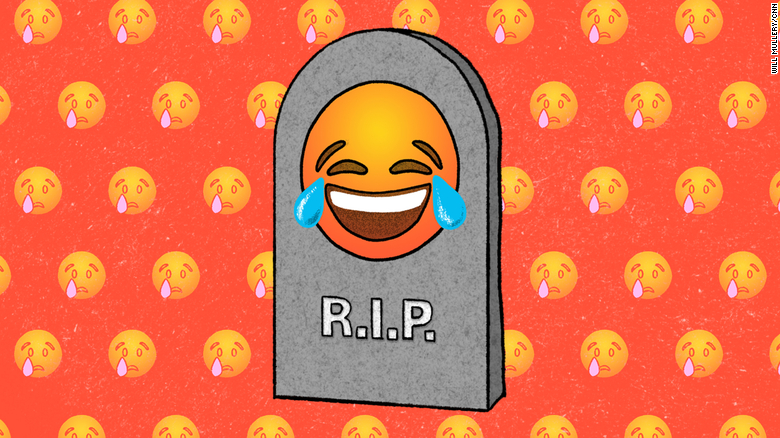Know which are the most used emojis 0:56
New York (CNN Business) -
Bad news for people who use the 😂 emoji frequently: It's not cool anymore.
In recent weeks, two internet-savvy generations have clashed in videos and comments on TikTok about the hallmarks of
millennial
or
millennial
culture
that are now considered uncool by Gen Z.
The list includes skinny jeans (Gen Z verdict: burn them), parted hairstyle (Gen Z verdict: middle part or nothing), and perhaps most painful of all, the popular cry and laugh emoji that some millennials have, including myself, they use hundreds of times a day, or more.
"What about the laugh emoji [?]" Asked one user in a TikTok comment.
Another replied, "It's so old."
In a different video of a woman who says she has stopped using it after learning that children don't, a teenage girl commented: “At 15, I say you should use that emoji because [because] we sure aren't going to to use".
Apple changes the look of its emoji with a mask
"I use everything but the laughing emoji," Walid Mohammed, 21, told CNN Business.
"I stopped using it a while ago because I saw older people using it, like my mom, my older brothers and only older people in general."
For many Gen Z members, the 💀 emoji has become a popular replacement for laughter.
It's the visual version of the slang phrase "I'm dying" or "I'm dying," which means something is very funny.
Other acceptable alternatives: the emoji 😭 (officially called "Loudly Crying Face" or face crying with intensity), or simply write "lol" (acronym in English for laughing out loud) or "lmao" (acronym for laughing until ... well, probably you already know the rest).
advertising
Xavier Martin, 17, said the emoji emo is "bland" and that "not many people" his age use it.
Stacy Thiru, 21, prefers the actual crying emoji because it shows more extreme emotion and feels more dramatic.
He said he couldn't even find the cry and laugh emoji on his iPhone keyboard.
A similar emoji, called "Rolling on the Floor Laughing" (🤣, laughing and rolling on the floor), is also not in fashion.
When asked about that emoji in a video call, Thiru made a visible face.
"I don't like that one," he said.
"Not even my mom uses it."
"Face with Tears of Joy", the official name of the laughing and crying emoji, is currently the most used emoji on Emojitracker, a website that shows the use of emojis in real time on Twitter.
It topped the Emojipedia list of the most used emojis on Twitter in 2020, while "Loudly Crying Face" came in second.
And it's had staying power: In 2017, Apple said the laughing and crying emoji was the most popular in America.
"Tears of Joy was a victim of its own success," said Gretchen McCulloch, Internet linguist and author of "Because Internet: Understanding the New Rules of Language."
"If you signal digital laughter for years and years in the same way, you start to sound insincere ... Hyperbole wears off with continued use," he said.
This is why Gen Z may be looking for novel ways to indicate that they are laughing in different ways.
Members of Generation Z, born after 1996, grew up at a time when the internet was already ubiquitous and was often in the palm of their hands.
Some millennials, by comparison, remember a time before constant Internet immersion;
many launched into the world of emojis and internet slang not through text messages or social media, but through AOL Messenger.
(Millennials were born between 1981 and 1996, according to the Pew Research Center.)
New emojis: a burning heart, couples with different skin tones, among others
Anecdotally, older generations tend to use emojis literally, while younger generations get more creative, said Jeremy Burge, emoji director at Emojipedia, an emoji dictionary website.
Emojipedia recently wrote a blog post that said, "It's common wisdom on TikTok that the laughing and crying emoji is for boomers."
Members of Generation Z told CNN Business that they like to assign their own meanings to emoji, which are then passed on to others in their cohort, often via social media.
For example, the emoji of a person wearing a cowboy hat (🤠) and that of a person simply standing have come to mean discomfort.
Others will string together a bunch of positive emoji, like stars, rainbows, and fairies, and then pair them up with something negative.
"Our generation is very sarcastic," Martin said.
Sometimes teens and twentysomethings use emoji, like the laughing and crying one, ironically, like sending six or seven of them in a row to their friends, to exaggerate it.
But, in general, that emoji is prohibited.
"For Gen Z, it is the same as having an Android," Mohammed said.
Emojis

